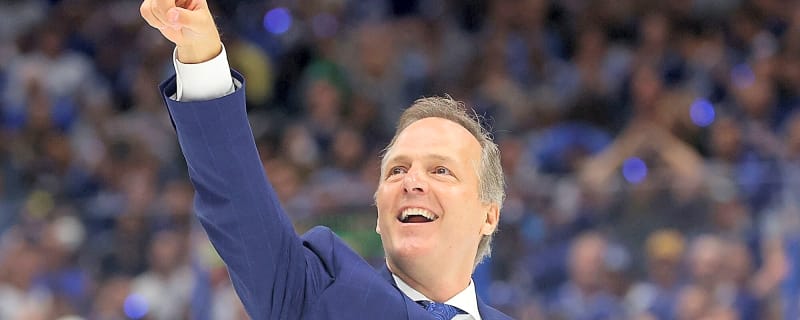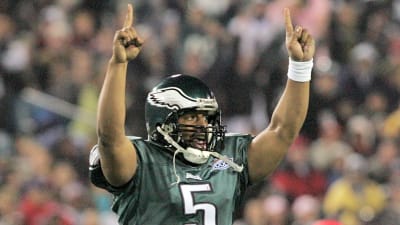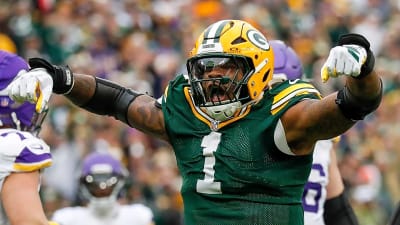- Home
- Quizzes
- My Quiz Activity
- Newsletters
- MY FAVORITES
- Add Sports/Teams
- SPORTS
-
NFL
- NFL Home
- Arizona Cardinals
- Atlanta Falcons
- Baltimore Ravens
- Buffalo Bills
- Carolina Panthers
- Chicago Bears
- Cincinnati Bengals
- Cleveland Browns
- Dallas Cowboys
- Denver Broncos
- Detroit Lions
- Green Bay Packers
- Houston Texans
- Indianapolis Colts
- Jacksonville Jaguars
- Kansas City Chiefs
- Las Vegas Raiders
- Los Angeles Chargers
- Los Angeles Rams
- Miami Dolphins
- Minnesota Vikings
- New England Patriots
- New Orleans Saints
- New York Jets
- New York Giants
- Philadelphia Eagles
- Pittsburgh Steelers
- San Francisco 49ers
- Seattle Seahawks
- Tampa Bay Buccaneers
- Tennessee Titans
- Washington Commanders
-
MLB
- MLB Home
- Athletics
- Arizona Diamondbacks
- Atlanta Braves
- Baltimore Orioles
- Boston Red Sox
- Chicago White Sox
- Chicago Cubs
- Cincinnati Reds
- Cleveland Guardians
- Colorado Rockies
- Detroit Tigers
- Houston Astros
- Kansas City Royals
- Los Angeles Angels
- Los Angeles Dodgers
- Miami Marlins
- Milwaukee Brewers
- Minnesota Twins
- New York Yankees
- New York Mets
- Philadelphia Phillies
- Pittsburgh Pirates
- San Diego Padres
- San Francisco Giants
- Seattle Mariners
- St. Louis Cardinals
- Tampa Bay Rays
- Texas Rangers
- Toronto Blue Jays
- Washington Nationals
-
NBA
- NBA Home
- Atlanta Hawks
- Boston Celtics
- Brooklyn Nets
- Charlotte Hornets
- Chicago Bulls
- Cleveland Cavaliers
- Dallas Mavericks
- Denver Nuggets
- Detroit Pistons
- Golden State Warriors
- Houston Rockets
- Indiana Pacers
- Los Angeles Clippers
- Los Angeles Lakers
- Memphis Grizzlies
- Miami Heat
- Milwaukee Bucks
- Minnesota Timberwolves
- New Orleans Pelicans
- New York Knicks
- Oklahoma City Thunder
- Orlando Magic
- Philadelphia 76ers
- Phoenix Suns
- Portland Trail Blazers
- Sacramento Kings
- San Antonio Spurs
- Toronto Raptors
- Utah Jazz
- Washington Wizards
-
NHL
- NHL Home
- Anaheim Ducks
- Boston Bruins
- Buffalo Sabres
- Calgary Flames
- Carolina Hurricanes
- Chicago Blackhawks
- Colorado Avalanche
- Columbus Blue Jackets
- Dallas Stars
- Detroit Red Wings
- Edmonton Oilers
- Florida Panthers
- Los Angeles Kings
- Minnesota Wild
- Montreal Canadiens
- Nashville Predators
- New Jersey Devils
- New York Islanders
- New York Rangers
- Ottawa Senators
- Philadelphia Flyers
- Pittsburgh Penguins
- San Jose Sharks
- Seattle Kraken
- St. Louis Blues
- Tampa Bay Lightning
- Toronto Maple Leafs
- Utah Mammoth
- Vancouver Canucks
- Vegas Golden Knights
- Washington Capitals
- Winnipeg Jets
- NCAAF
- NCAAM
- Olympics
- Boxing
- Entertainment
- Lifestyle
- Golf
- MMA
- Soccer
- Tennis
- Wrestling
- Sports Betting
- More Sports
- RESOURCES
- My Account
- YB on Facebook
- YB on Twitter
- YB on Flipboard
- Contact Us
- Privacy Policy
- Terms of Service
Maple Leafs need to make a decision on Easton Cowan
Toronto's handling of Cowan doesn't make a lot of sense.

Maple Leafs GM Brad Treliving gives vote of confidence to coach Craig Berube
After the Toronto Maple Leafs fired assistant coach Marc Savard on Monday, there were some questions regarding if that would be the only move made amid a massive slide, particularly with Craig Berube.

Team USA would be setting itself up for Olympic failure if Stars' Jason Robertson is left off roster
As things stand entering play on Tuesday, Robertson's 23 goals are fourth-most in the entire NHL.
Airing hockey grievances for this Festivus day
If you exist within the hockey world at all, you probably have no shortage of grievances to air on this Festivus Day.

The 'All-time points leader by NHL team' quiz
Can you name every NHL franchise's all-time leader in points in five minutes?
What Christmas gifts do NHL teams need heading into the second half of the season?
If you could get your favorite team one gift for the holiday season, what would it be?
Who is the winningest coach for every NHL franchise?
NHL head coaches have to hire good assistants. They have to set an overarching philosophy, juggle lineup configurations, and do the kind of “man management” that is impossible to track statistically.

Matvei Michkov and Rick Tocchet's relationship continues to garner attention despite Flyers' success
The Philadelphia Flyers are hanging with the best teams in the league, but their success is being overshadowed by the relationship between one of the team’s star players and its bench boss.

Three underperforming NHL players who must step up
We’re deep enough into the NHL season now that patience is starting to wear thin for some around the league.

Canadiens HC Martin St. Louis must address Nick Suzuki problem soon
When Martin St. Louis sent his captain, Nick Suzuki, over the boards to try and tie the game in a shootout against the Pittsburgh Penguins, the Canadiens' fate was almost sealed.

Why is Marc Savard the only change the Maple Leafs made?
While the power play has been a massive issue for the Leafs, it’s far from the only thing plaguing the group.

Why did Canadiens reverse course on goalie Samuel Montembeault?
The Canadiens' explanation raised eyebrows among some observers.

Why Mario Lemieux remains greatest Penguin despite Sidney Crosby's achievement
On Sunday, Crosby reached a cherished franchise milestone, passing Lemieux for the most total points in Penguins history.

Sidney Crosby breaks longtime Penguins franchise record
The Pittsburgh Penguins' 4-3 win over the Montreal Canadiens on Sunday night was significant for several reasons

Phillip Danault's first words to Canadiens fans following Kings trade
Two days after being traded from the Los Angeles Kings to the Montreal Canadiens, forward Phillip Danault shared a message with the fans.

Canadiens alter goaltending plan before game vs. Penguins
Montreal Canadiens goaltender Samuel Montembeault spent the past few days on loan to the Laval Rocket. The Quebec-born player had been assigned to the AHL for a conditioning loan, but something changed since then.

Canadiens players take firm stance on Phillip Danault trade
The Montreal Canadiens have acquired Phillip Danault from the Los Angeles Kings.

Canadiens' latest acquisition could fill void left by Jake Evans injury
Although they defeated the Pittsburgh Penguins 4-0, the Montreal Canadiens delivered bad news to their fans.
Are the Carolina Hurricanes the top team in the Eastern Conference?
The Carolina Hurricanes have had another excellent start to their season, as their 22-9-2 record has them first in the Eastern Conference by a five-point margin.

New Sabres GM Jarmo Kekalainen fires associate GM Jason Karmanos
It turns out a GM change wasn’t the only front office move the Sabres are making this week.

Trent Frederic gives baffling answer on his role with the Oilers
Not even half way through the first season of Frederic's contract, it’s already looking like a massive flop.

Canadiens receive positive Mike Matheson injury update
Montreal Canadiens defenseman Mike Matheson has been dealing with an upper-body injury, and he used the team's day off to resume training.
Montreal Canadiens acquire Phillip Danault from Kings
A familiar face has returned to Montreal, as the Canadiens have announced that they have acquired Kings forward Phillip Danault in exchange for the Blue Jackets’ 2026 second-round pick.

Pittsburgh Penguins' Sidney Crosby could become all-time leading scorer in franchise history this weekend, set to pass legendary Quebecer Mario Lemieux
Sidney Crosby could take advantage of his visit to Montreal on Saturday to become the all-time leading scorer for the Pittsburgh Penguins, surpassing the legendary Quebecer Mario Lemieux.
Zach Werenski continues to be incredibly important to the Blue Jackets
The Columbus Blue Jackets have not quite made the jump that many expected from a talented young core that showed tons of promise down the stretch last season.
Former NHLer T.J. Oshie discusses the challenges of getting players to wear neck guards
In the wake of the on-ice death of Adam Johnson, former NHL star T.J. Oshie embarked on a mission toward increasing usage of neck guards to keep players safe.
Breaking News
Trending News
Customize Your Newsletter
 +
+
Get the latest news and rumors, customized to your favorite sports and teams. Emailed daily. Always free!
PRIVACY POLICY EDITORIAL POLICY CONTACT US
ABOUT YARDBARKER TERMS OF SERVICE
Use of this website (including any and all parts and
components) constitutes your acceptance of these
Terms of Service and Privacy Policy.
This site is for entertainment purposes only.
There is no gambling offered on this site.
Gambling Problem? Call 1-800-Gambler.

 Free Newsletters
Free Newsletters


















